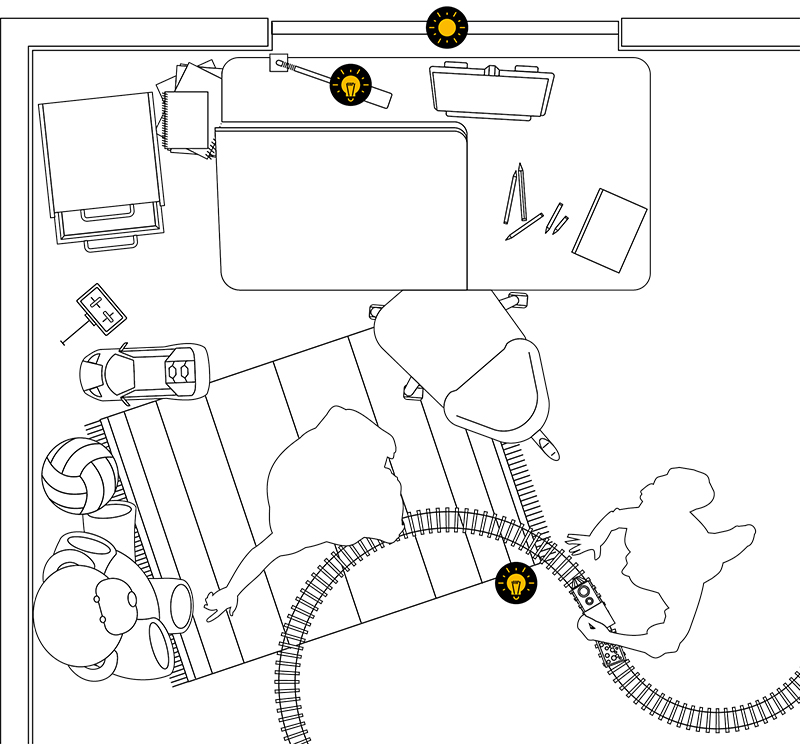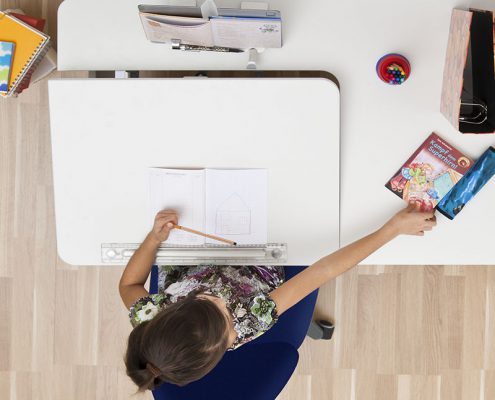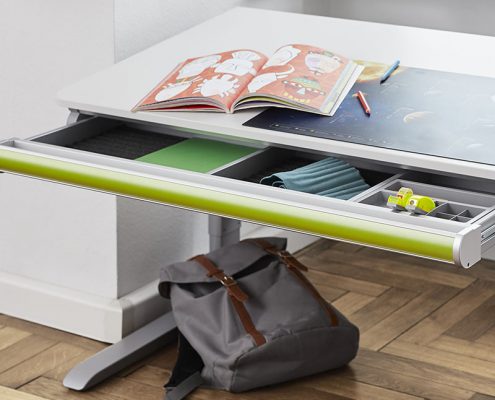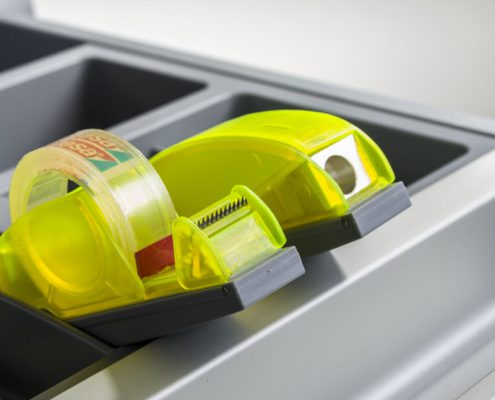What does the children’s room for first graders look like?
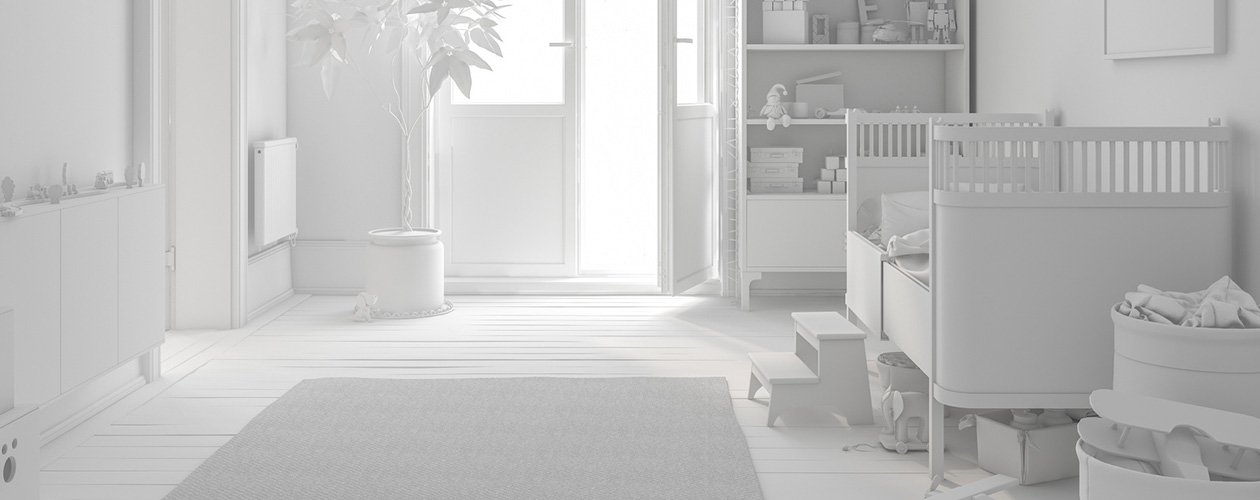
Children need a place for their development that offers enough space – for moving, learning and playing. If the child is still small, he or she usually likes to play near the parents. For example, building blocks are often played with in the kitchen or living room. The toy area can be easily distinguished from the rest of the living area by means of a room divider.
If the “playground” in the living room or kitchen is no longer sufficient or school enrolment lies ahead, the time is right for the child to move into their own room. The Hamburg home psychologist Dr. Antje Flade explains: “Entering the school makes it increasingly important to have your own room. The children’s room has several functions for children of school age and older.
It is a place for school work and a place where children can be alone or together with their peers without being disturbed by adults. The own room is a multifunctional room for school children. It is a study, play and living room at the same time.
For parents the question arises, which furnishing is important for the children’s room. The three areas of playing, sleeping and learning must now be well integrated into the children’s room – therefore a good room concept is necessary.
The learning area plays a central role in the children’s room. It is subject to constant change and must meet the most varied requirements – after all, “learning” is different at varying ages and in the individual phases of life. Therefore learning furniture should be flexible and be adaptable to any new order. The size of the room also determines the design of the learning place. Good planning is required.
The children’s room does not always suit the taste of the parents and it does not always fit into the overall appearance of the apartment. What makes a good children’s room? It should be comfortable and practical at the same time. A good children’s room does not always have to be completely full, there should also be enough free space to play and rest.
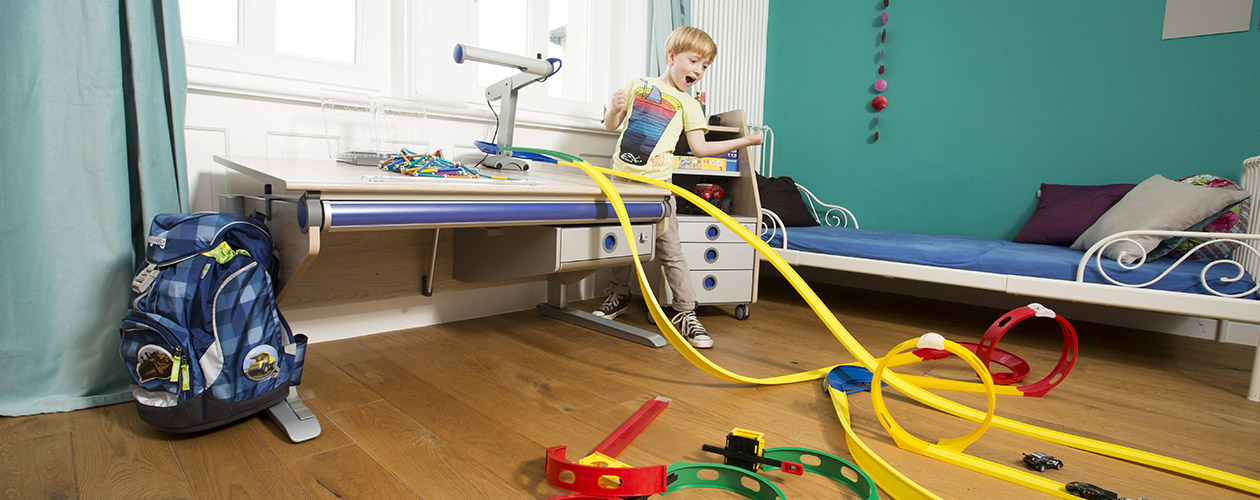
What new children’s room furnishings does a first grader need?
Checklist for the new children’s room:
- Height-adjustable desk
- Adjustable desk chair
- Mobile pedestals
- Desk lamp
- Storage space for pens and handicraft materials
- Shelf for books
How is the children’s room properly furnished? Intelligent furnishing!
Of course, the child’s taste changes over time. What a child at six years of age likes, he or she no longer likes at the age of nine or ten. In order not to have to completely remodel the children’s room every few years and to keep financial and time expenditure low, we have the following tips for parents:
- The child should add his or her own ideas
- The basic equipment of the children’s room should ideally last an appeal for many years
- When buying, attention should be paid to a timeless and changeable design
- The furniture should still be appealing to the child even after ten years
- In order for furniture to last the quality is important

What is useful children’s furniture? They are ergonomic and changeable!
Furniture for children must not be boring and by no means too big or too small!
But a good desk should not only be adjustable in height. There are chairs and tables that grow with the child. Tables can be tilted if children have problems sitting upright while learning. Spontaneously turn a seat for writing, handicrafts or reading into a standing spot? This relieves the one-sided muscular strain when sitting by changing between sitting and standing.
Movement breaks between homework or other sitting activities also help to avoid postural stiffness. Of course, ergonomically shaped swivel chairs are also recommended, with backrests that can also be adjusted. Chairs that tilt slightly with the chair when leaning back provide the necessary relief for the spine.
Desks from moll can be changed in many ways, as they have, for example, colour elements that can be swapped. Children’s furniture by moll can be used by schoolchildren from primary school to high school due to its height adjustability. Furthermore, there are various attachment options for more storage space, from a side top to a flex deck. The huge drawer or the matching mobile pedestals also keep things tidy.
Finally, the ergonomic properties of the desk chair and desk must also be taken into account, because the chair and table must be adjustable in such a way that they are ergonomic in every phase of growth in order to ensure healthy sitting at the desk. Since children grow about seven centimetres a year on average, regular adjustment of table height and chair settings is indispensable. You can watch our video on our YouTube channel to see how to make the right settings.
Where is the optimal workplace in the children’s room?
The optimal location for the first desk should be bright: a place at the window would be ideal. On the one hand, the window provides sufficient brightness and on the other hand, a window also offers a relaxed view outside. If the desk is placed at the right angles to the window, please ensure that the (writing) hand of the first grader does not cast an unpleasant shadow on the paper. It is therefore important whether the child writes with the right or the left.
Good lighting at the learning place
In principle, good lighting must be ensured. Even if there is an optimal place for the desk with daylight, an additional desk lamp is necessary – if only for the dark seasons.
A small desk lamp is not only a beautiful eye-catcher, but also fulfils its purpose. The lamp must be bright enough, but it must not dazzle and should emit a cosy light. You can choose a lamp for clamping or a classic floor lamp. In both cases, the lamps should be flexible so that the light source can be optimally positioned.
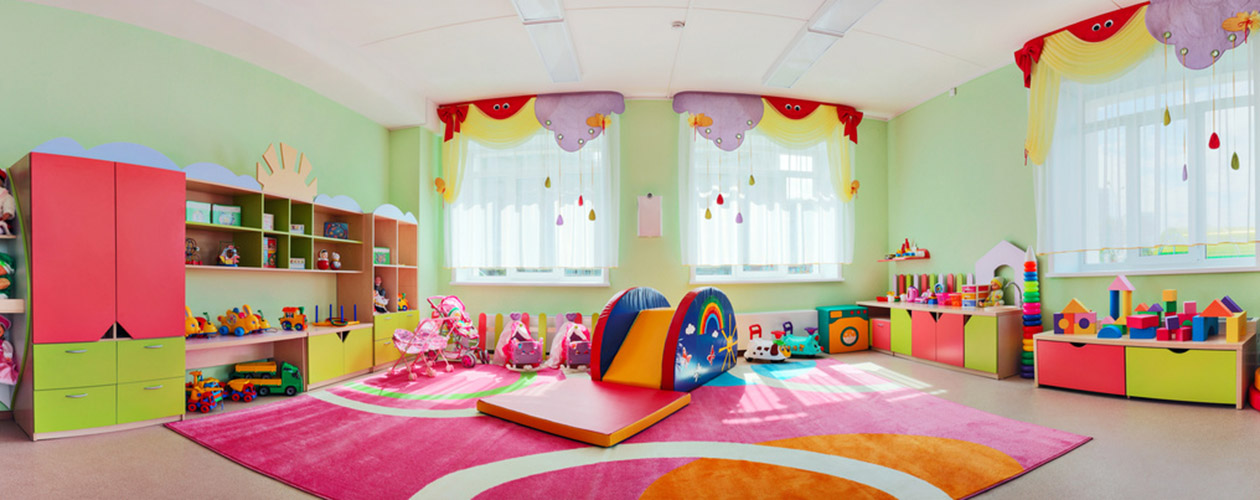
Motivate your child with colour design and individual furnishing solutions
Pink for the girls, blue for the boys. Is that the way it has to be?! Far away from traditional classifications, colours deliberately chosen for children’s rooms can make a big difference: With a well thought-out colour concept, rooms are visually enlarged or reduced in size. Light colours make the room appear larger and airier, while dark tones create a feeling of tightness, but also of shelter. In addition, colours influence our sense of well-being. Those who familiarize themselves with the theme of colour effects before designing their children’s rooms create a cosy refuge for their children and unfold their creativity.
Everything in your favourite colour? Green today, yellow tomorrow and orange the day after tomorrow: children’s favourite colour changes often. If you focus exclusively on theier current favourite colour for interior design, you will quickly face backlash when the colour is no longer in favour of the little ones. Parents are well advised to use interchangeable accessories to reflect today’s colour taste.
The growing desks from moll can also change colour at any time: At the Champion desk, for example, the colours of runners, handles and stakes can be changed easily. The decorative elements are supplied in a stylish box with each table and can be replaced in no time at all. For those who like it even more colourful, the Champion also offers side parts in various shades: from light green to purple – there is the right colour for everyone.
The choice of colours in the children’s room and their effect
“For the basic colouring in the children’s room, a highlight colour can of course be used, but we would always use it selectively rather than over a large area. Toys, books and the like already bring enough colour with them. It is visually calmer if they are stored in closed boxes,” says interior designer Katharina Holzer from the “kinderzimmerei” furnishing team, which specialises in interior design for children.
“Discreet colours for the walls, floor and furnishings ensure a pleasant atmosphere. For example, the combination of furniture in white shades and a wall design in light shades such as warm grey or cream appears fresh and harmonious,” says Katharina Holzer.
Extra colour tip: Check room conditions
Before you start with the colour design, the conditions of the room must be taken into account: If the room is rather cool, for example due to its northern facing position, a warm tone should be chosen for the wall colour. If, on the other hand, the room is flooded with light and facing south, a cooler colour can create a balance.
Ensure sufficient storage space in the children’s room!
Many new things make their way into the children’s room when school starts: books, paper, exercise books, pens, schoolbags, a world map and much more.
When toys and the like are scattered all over the floor, pillows and blankets pile up, then for many children their room is in perfect order. Parents usually see things differently and wish for children, who care about tidiness. “Children are not born with a sense of tidiness, but they can learn it,” says Ursula Kittner from Düsseldorf, who has made the topic of organising and structuring her professional work. As an expert on order, she helps people to live more stylishly, to sort themselves and to throw off unnecessary ballast.
Ursula Kittner: “This is where parents come in. Ideally, they do not force their own understanding of order upon their children, but motivate them to find their own system that can then be applied to all areas of life. This begins with the teaching of simple basic structures that are gradually establishing themselves: Open doors and drawers should also be closed again because you don’t bump into them as often or fall over things when they have their fixed place in a fixed room.
When it comes to storage space, the “intelligent organisation” plays the most important role. A child should be able to access the toys easily without having to climb onto a chair, for example. Here, for example, the box principle is suitable. Children can quickly create order and know for themselves what is in which box. School children must learn from the beginning to keep order in their own room. If too many things lie around, it also distracts quickly.
Work materials for school and homework should be placed close to the workplace, so that they are easily accessible. Many desks have integrated drawers. This is especially practical for smaller utensils such as pens, ruler and the like. Nevertheless, it makes sense to offer space for books and other items near the desk. For all storage furniture, it is certainly an advantage if they are placed in the immediate proximity of the desk. Mobile containers offer the most flexibility and are real space miracles!
The school bag becomes a central part of the child’s life. But it also becomes an accessoire that is everywhere and nowhere at home. Here, a hook directly at the desk is recommended, so the school bag has a fixed place!
Space for the cuddle area
Structuring the children’s room with a ‘place of relaxation’ also makes sense. It is advisable to define areas for different activities that motivates to do the same – for example for playing and romping around or for painting and writing. Everyone benefits from this: the specially equipped play corner inspires the imagination of young discoverers and inventors – the readiness of writing utensils, crayons and school documents at a sensibly furnished desk stimulates both to get started and to clean up.
However, just like the ergonomic workplace and the toys area, a cozy corner in every child’s room is also of great importance: it is a place to dream, cuddle, recharge one’ s strength and read. According to scientific research, rest areas for children are even more important than the accumulation of many toys. They mean freedom and space for the little ones. Here kinds don’t have to concentrate, they can dream, indulge in their thoughts, read a book or simply cuddle.
Learn more tips on school enrolment from our guide for first graders …..
…. with tips for the time after the 1st day of school
Learn more tips on school enrolment from our guide for first graders …..
…. with tips for the time before school enrolment

